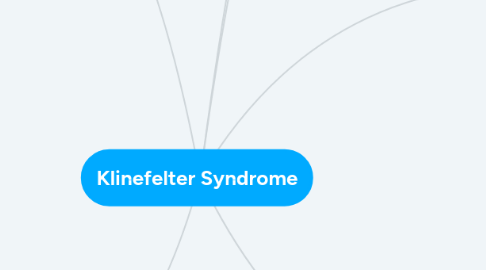
1. Diaganostic Test
1.1. Prenatally
1.1.1. Cytogenetic analysis on chorionic villi or amniocytes
1.1.2. Analyzation of cell-free fetal DNA circulating in maternal blood
1.2. Age related signs
1.3. Karyotype Analysis on peripheral blood lymphocytes
1.4. XCAT-KS buccal swab test
1.5. Florecent in-situ hybridization
1.6. Microarrays
1.7. Androgen receptor gene quantitative real-time polymerase chain reaction technique
1.8. Hormone testing
1.8.1. Follicle stimulating hormone
1.8.2. Luteinizing hormone
1.8.3. Inhibin B levels
1.8.4. Testosterone
1.8.5. Estradiol
1.8.6. Prolactin
1.8.7. IGF-1
1.8.8. Cortisol Levels
1.8.9. Osteocalcin levels
1.8.10. Urinary gonadotrophins
1.9. Bone Density Screening
1.10. Hypercoagulability
1.11. Imaging Studies
1.11.1. Ecchocardiogram
1.11.2. Radiology
2. Common Findings
2.1. Female distribution of adipose tissue
2.1.1. Gynecomastia
2.2. Sparse or absent body hair
2.3. Decrease Muscle Mass
2.4. Decrease Strength
2.5. Decrease physical endurance
2.6. Small testes and penis
2.7. Diminished labido
2.8. Voice often high pitch
2.9. Tall stature
2.10. Moderate degree of mental imparment
3. Sex chromosome aneuploidy
4. Pathophysiology
4.1. Male born with an extra X chromosome
4.1.1. X chormosome
4.1.1.1. Testes disfunction
4.1.1.1.1. Maybe sterile
4.1.1.2. Brain Development
4.1.1.3. Growth
4.1.2. Cognitive and Physical abnormalities
4.1.2.1. Mental and physical impairment depends on increase number of X chromosome
4.2. Paired X chromosome fails to separate in meiosis I or II
5. Causes/Risk factors
5.1. Born with an extra X chromosome
5.2. Increase maternal or paternal age
5.3. Maternal or paternal meiotic nondisjuction account for 50% of cases
5.4. Not inherited
5.5. Paired X chromosome fails to separate in meiosis I or II
5.6. Higher risk for..
5.6.1. Autoimmune disease
5.6.2. Diabetes
5.6.3. Osteopenia
5.6.4. Osteoperosis
5.6.5. Tumors
5.6.6. Systemic Lupus Erythematosus
5.6.7. Rheumatoid Arthritis
6. Treatment
6.1. Androgen replacement therapy
6.2. Speech and Behavioral therapy
6.3. Physical and Occupational therapy
6.4. Treatment for infertility
6.4.1. Artificial Reproductive Technology (ART)
6.4.2. Microsurgical Testicular Sperm Extraction (TESE)
6.4.3. Intracytoplasmic Sperm Injection
6.5. Genetic Counseling
6.6. Reproductive genetic counseling
6.7. Masectomy
6.7.1. To treat gynecomastia

